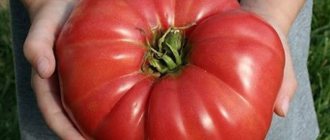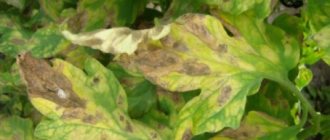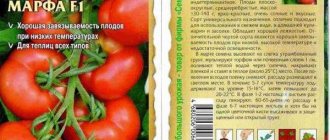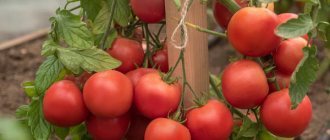| Ripening period: | early ripening |
| Shape, weight of fruits: | round, 200-250 g |
| Bush type: | determinant |
| Growing regions: | all Russia |
| Productivity: | 6.1 kg per 1 sq. m. |
Recently, early large-fruited hybrids have become popular among gardeners growing tomatoes on their farms. Due to the short growing season and the inherent productivity of hybrid forms, they are capable of producing large yields. The Azhur tomato has been available to vegetable growers since 2007, when it was registered in the State Register. Belongs to the category of the best early tomatoes for open ground.
Characteristics and description of the Azhur variety
Azhur tomatoes are hybrid, intended for cultivation in ordinary beds and in greenhouses on personal plots and on the plots of small farmers. The variety can be grown in all regions of the Russian Federation, in the south and in the middle zone - in beds, in Siberia - in simple and heated greenhouses.
Description of tomatoes Azhur F1:
- determinate, standard plant;
- leaves are green, large;
- simple inflorescence;
- stalk with articulation;
- fruit is round in shape, dense, with smooth skin;
- the color of an unripe tomato is light green, a ripe one is red;
- number of seed chambers – 4-6.
The productivity of the Azhur hybrid is 6.1 kg per 1 sq. m with an average weight of 1 fruit of 0.2-0.25 kg. The tomatoes taste good. They can be used for fresh eating, for processing into tomato products and for pickling in barrels.
The appearance of Azhur tomatoes can be seen in the photo.
General information about culture
The hybrid tomato variety Azhur was obtained by Russian breeders for cultivation in greenhouse conditions in the northern regions of the country. However, the plant feels great and shows excellent results in open ground in the Krasnodar region, Astrakhan region, and in the central regions of Russia.
The tomato variety f1 Azhur was registered as a new vegetable crop in 2007. It has become popular among vegetable growers, as it not only has high productivity, but is also resistant to late blight, black leg, cracking and drying of fruits.
Tomato f1 belongs to the determinate type, that is, the stem of the plant stops growing after several clusters appear on it.
Tomato Openwork
Openwork is a table variety and is universal in use. Small tomatoes can be canned, and large ones can be eaten fresh. The variety is also ideal for making tomato juice and paste.
Comparison with similar hybrids
Other hybrid tomatoes have approximately the same properties - early ripening, determinacy, ability to grow in almost any climate, classically shaped fruits weighing approximately 200-250 g. These are varieties such as:
- Blagovest F1;
- Leopold F1;
- Verlioka F;
- Impala F1;
- Nobleman.
In addition to them, there are many more hybrids of domestic and foreign selection that gardeners can pay attention to when choosing tomatoes to grow in their beds.
Sowing dates and growing seedlings
Hybrid seeds for seedlings are sown in March and April, depending on the region. It grows for 1.5-2 months, so the sowing time must be calculated so that transplanting to the beds occurs at a period when cold snaps and frosts are no longer expected. The seeds are sown directly into the ground only in the south.
Since Azhur tomatoes are hybrid, seeds will need to be purchased every year. It is not advisable to collect them from your plants - they do not retain their characteristic characteristics.
If the seeds are not treated with anything and they do not have a protective shell, then they must first be disinfected in potassium permanganate, a solution of hydrogen peroxide or in solutions of fungicide-protectants. Keep the potassium permanganate in the pink solution for 20-30 minutes, and in the fungicides for as long as indicated in the instructions.
After processing, the seed should be washed in clean water and placed in a damp cloth for a day. Swollen seeds germinate faster.
It is most convenient to grow Azhur tomatoes in individual containers: in small pots made of plastic or peat, in cassettes with large cells. It is not advisable to sow in common boxes; in this case, the grown plants will have to be picked. In growing tomatoes, Azhur is an optional procedure, so you can do without it.
Another advantage of pots is that when planting, if everything is done carefully, the lump of earth will not crumble and the roots will not be injured. Such seedlings take root much faster and grow faster.
The substrate should be light, loose, fertile, containing all nutrients. Ready-made industrial soil specifically designed for growing vegetables is ideal. Fill containers with it almost to the top, do not compact them.
Sow seeds 1-2 pcs. into each pot, carefully water with warm water and sprinkle with fertile mixture. Cover with film and place in a warm place with a temperature of at least 25˚C.
When sprouts appear, remove the film and lower the temperature slightly. This will stop the growth of the seedlings and prevent them from stretching out at the very beginning.
In addition to a constant temperature, seedlings need proper lighting - it is necessary that the light falls on the plants for at least 10-12 hours a day. If there is less daylight, the tomatoes may stretch out and become pale. In March, when the days are still short, you can use fluorescent lamps. They should be turned on every evening and morning.
Growing seedlings need regular watering and several feedings. Water it so that the soil is moist but not soggy. In wet soil, there is a high probability of blacklegs appearing on tomatoes. The water should be warm, preferably free of chlorine. It is convenient to water from a small watering can with a fine-mesh nozzle.
Complex fertilizers with microelements are suitable for feeding. For good seedling growth, it is enough to feed it every 2 weeks.
The last stage of cultivation is hardening. It begins 1-1.5 weeks before the intended transplantation of seedlings to open beds. The plants are first cooled for 1 hour, but every day the time is increased by 0.5-1 hour. For those tomatoes that will grow in greenhouses, hardening is not carried out.
By the time of planting in the beds, the seedlings should be approximately 15 cm tall, with thick stems and dark green foliage.
Planting in the ground and caring for tomatoes
There are no strictly defined dates here. It is necessary to look at the weather and climatic features of the area. If frosts often occur in the spring, then you need to wait until they pass. For reliability, you can cover the newly planted plants with film, stretching it over metal arches installed above the beds.
The hybrid is planted in open ground in May or early June. Azhur tomato bushes are not very tall and not spreading; they will have enough space in the beds when planted according to the scheme of 40 cm in a row and 60 cm in rows. You can plant them in furrows or holes. Their depth should be slightly greater than the pots in which the seedlings were grown.
After planting, the plants need to be watered and mulched on top with a layer of hay or sawdust. The covering material will reduce the rate of moisture evaporation, prevent the soil from compacting and weeds from growing, thereby allowing the gardener to save time and effort in caring for plants.
While the tomatoes are taking root, they need to be watered well. The soil should be kept moist until the tomatoes take new roots. After rooting, the frequency of irrigation can be reduced, but the volume of water poured must remain sufficient.
Tomatoes need moisture most during the flowering and fruiting period. When most of the tomatoes turn red, stop watering to prevent them from cracking.
If the soil was fertilized before planting, the first feeding of the plants is carried out after 2-3 weeks. At this time, vegetable crops need nitrogen for the growth of green mass; they consume less phosphorus and potassium.
As nitrogen fertilizers for tomatoes, use ammonium nitrate or urea (1 tablespoon per 10 liters) or organic fertilizers. They are obtained by infusing 10 parts water to 1 part manure for a week. Plants are watered with this solution - 0.5 liters per bush.
The second feeding is carried out when most of the fruits have set. Now phosphorus and potassium should predominate in fertilizer mixtures. You can use any mixtures that contain these elements, except those containing chlorine.
Mineral fertilizers can be replaced with ash - 1 cup per 1 bucket. The third (when all the fruits have set) and, if necessary, the fourth fertilizing is done with the same composition.
You can also use complex fertilizers like Crystallon. This is even more practical, because they contain not only basic nutrients, but also many microelements that plants need no less than nitrogen, potassium and phosphorus.
There is no need to shape Azhur tomatoes, since they are standard. It is advisable to tie it to a support, since the plants are large-fruited: when the tomatoes begin to grow, branches may begin to break under their weight.
The fruits of the hybrid are collected as they ripen. As indicated in the description, the first harvest is harvested 105-110 days after germination. Tomatoes can be picked either fully ripe or slightly unripe. You can use them to prepare various dishes and preserve them.
Thanks to their thick skin, Azhur tomatoes can be stored for 2-3 months in a cold room.
Greenhouse preparation
Since greenhouse spaces receive the same crop every year, soil cultivation here also needs to be given maximum attention. At least once every three years, the top layer of soil should be removed and the soil and all parts of the greenhouse should be disinfected in the spring with a solution of copper sulfate. Tomatoes are strong crops that can deplete the soil, so timely application of fertilizers is a necessary condition for increasing the fertility of greenhouse soil. Organic is the best feeding. At least 20 kg of humus is added per square meter of soil.
Diseases and pests of the hybrid
As noted in the characteristics of these tomatoes, they are resistant to verticillium, root and crown rot, powdery mildew and suberization of roots.
Pests on tomatoes include slugs and spider mites. Ash mixed with a small amount of red pepper helps against slugs. The powder should be sprinkled on the surface of the earth around the plants, this will prevent the pest from climbing on them.
Ash-tobacco or soap infusion helps against spider mites. If folk remedies fail, you can use insecticides: Fitoverm, Actellik, Akarin, Fufanon, etc.
When tomatoes ripen, chemical insecticides should be used no later than the period specified in the instructions.
Advantages and disadvantages
The Azhur F1 tomato has the following advantages: it is low, standard, does not require mandatory gartering and shaping, which saves the work of the vegetable grower. The hybrid is quite resistant to common diseases and heat, its fruits have an excellent taste, are large in size, and are universal in use. The yield of the hybrid corresponds to the indicators for determinate varieties.
There is, perhaps, only one drawback - the largest fruits cannot be preserved in jars. Otherwise, Azhur tomatoes have no significant disadvantages.
Soil preparation
Azhur F1 tomatoes prefer air- and water-permeable, well-warmed loamy soils. In open spaces, this vegetable is grown in elevated areas or raised beds. The best predecessors, previously grown in areas where tomatoes are supposed to be planted, are cabbage, zucchini, and cucumbers. You cannot use former potato beds, since the diseases of potatoes and tomatoes are identical and can slow down development. The soil is prepared in the fall: humus or compost, wood ash and superphosphate (50 g/1 m2) are added for digging.
If there is no possibility of changing the place for planting the tomato, then the area is treated with a solution of copper sulfate. Then they dig well and add any high-quality organic matter, for example, humus.










